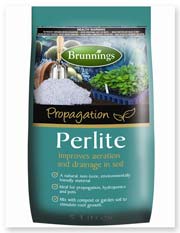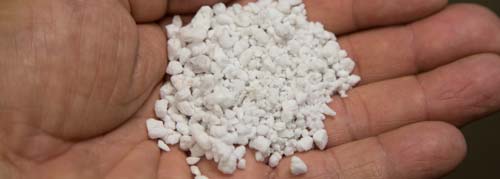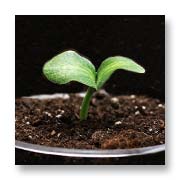If you had the ideal soil for your garden it would
- drain well,
- remain open and aerated
- maintain access to moisture for plants,
- keep roots well insulated,
- deliver nutrients efficiently
- and avoid compaction.
 So no matter how bad you soil is – if you add Perlite then you’ll be on your way to enjoying all of these attributes.
So no matter how bad you soil is – if you add Perlite then you’ll be on your way to enjoying all of these attributes.
Perlite is a super lightweight volcanic glass that when heated to over eight hundred degrees Celcius expands as much as twenty times its original size due to water trapped inside that attempts to evaporate in the heat - not unlike popcorn but much tougher. It is this is property that makes Perlite such a unique mineral and an excellent soil additive.
Aeration:
When mixed with soil, Perlite keeps soil aerated. Its hardness along with very low density and internal pockets of air keep soil from compacting around it, and as a result, roots can more easily penetrate deeply. Its unique air qualities also balance soil temperature and insulate roots against rapid temperature changes.
Drainage and Moisture Access:
This aerated soil drains water effectively too. In addition to soil aeration, Perlite holds moisture very efficiently but does not become waterlogged if you overwater or in prolonged wet weather.
Sterile:
Perlite is totally toxin-free and therefore safe for all plants. Some other soil additives can carry insects, pests and disease if they haven’t been properly treated in advance. Perlite, however is a sterile mineral due to the high-temperature process and also has a neutral pH.

Low Cost:
Many soil additives can be expensive, particularly if you buy then in larger quantities. Perlite however is at the lower end of costs and due to its light weight can be purchased and carried home easily in quite large bags. It is also inorganic so won’t break down, remaining in your soil, doing its good work for years to come.
Quantities:
Though many plants will grow in 100% Perlite, the most effective use of it is as an additive to your garden soil.
We recommend a maximum of 50/50 split between normal, loamy soil and Perlite. Make sure you mix it in thoroughly though.
 Seedlings:
Seedlings:
Some potting mixes have some Perlite or Vermiculite already mixed in with them, but if it is not mentioned on the bag label then we highly reccomend adding some yourself when you set up your ssed trays or pots to strike seedlings later. Again a 50/50 mix is recommended.
Rooting Cuttings:
Perlite is also very good for getting cuttings to root, though here it is best used 100% - with no soil.
Soak the Perlite first so that it holds maximum moisture, place some in a plastic bag - around one third of the bag capacity and then insert the cutting up to a budding node.
Ensuring there is plenty of air also in the bag, seal it arpound the neck with a rubber band and leave it in a warm location for a week or so.
Roots will form very easily in the optimum mixture of warmth, moisture and air - and much better than just inserting the cutting into water.